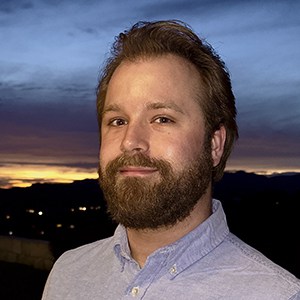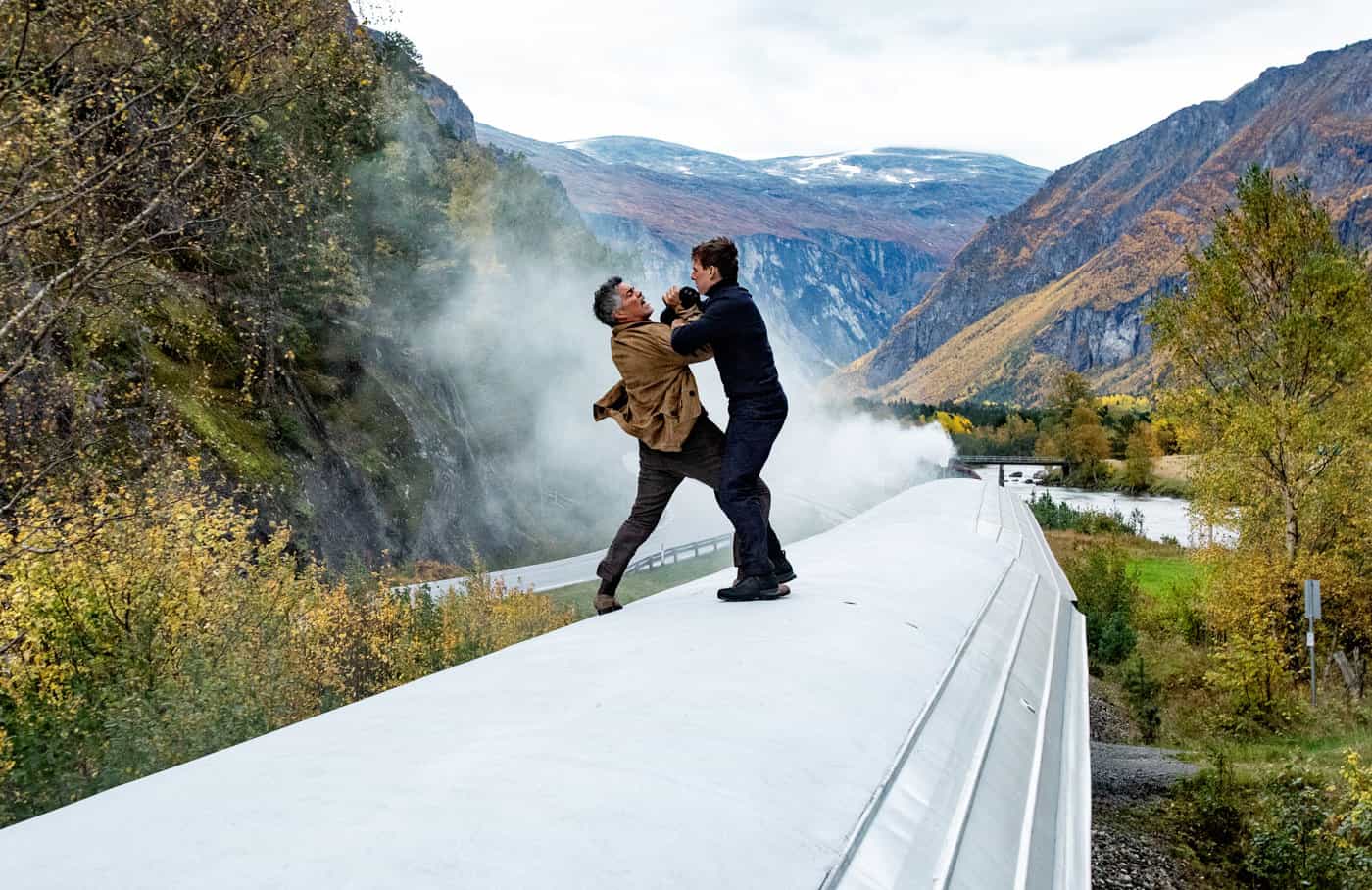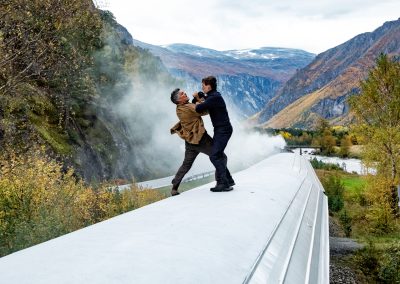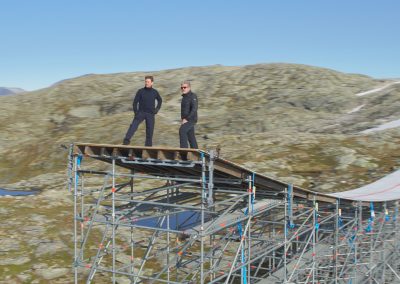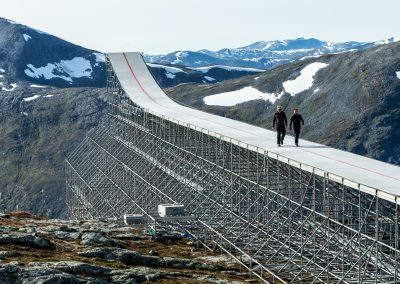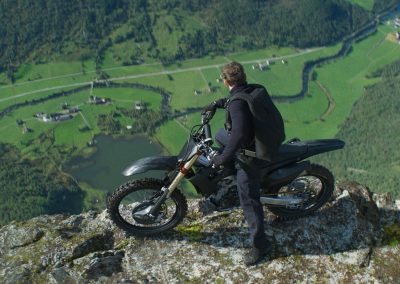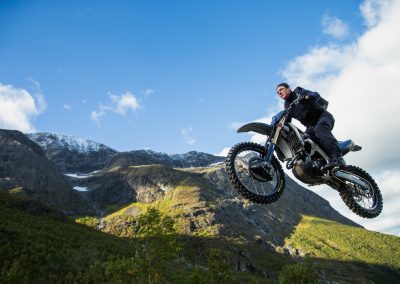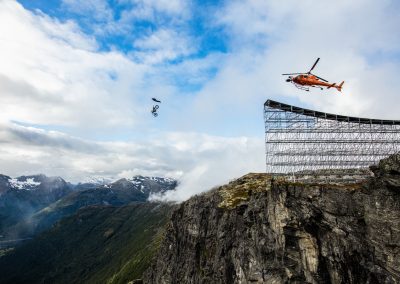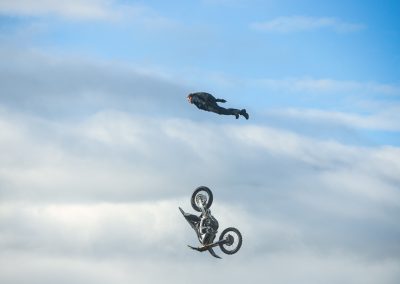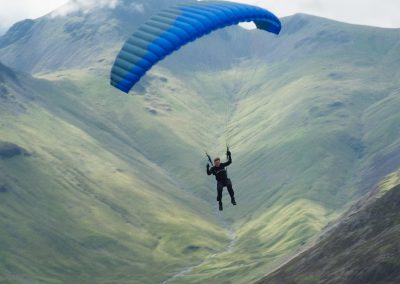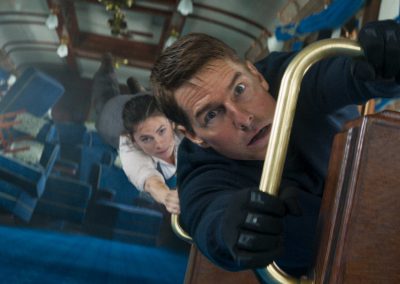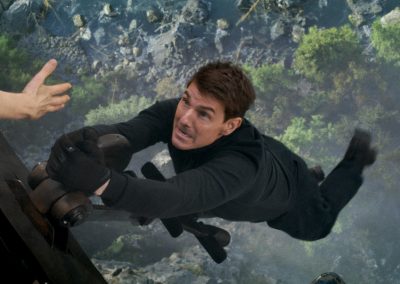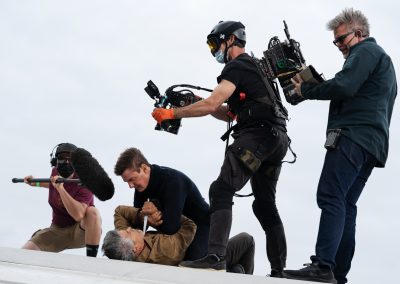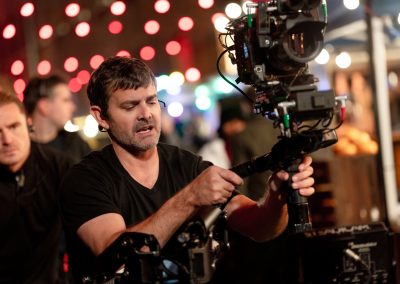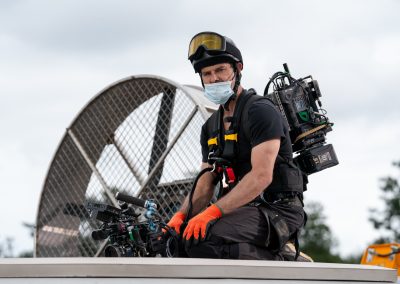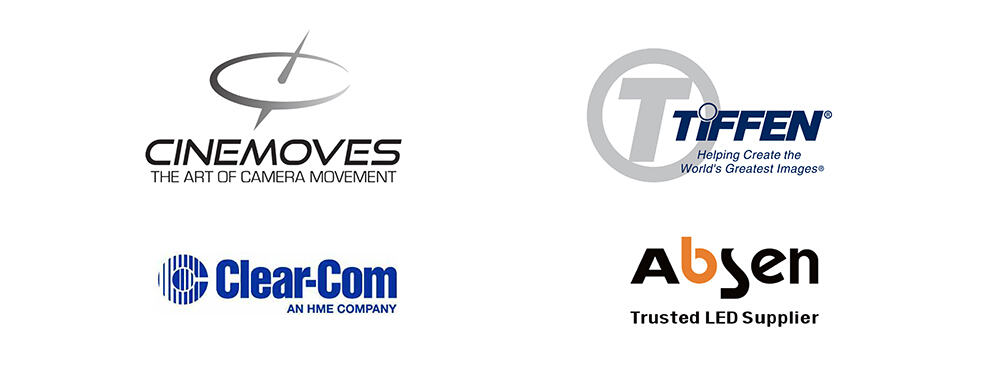Mission: Impossible–Dead Reckoning Part One:
Shooting an Impossible Mission
A Conversation with Chunky Richmond
By David Daut
From relatively humble beginnings, the Mission: Impossible movies have grown into a vehicle for Tom Cruise—perhaps our last true movie star—to defy death through increasingly preposterous stunts in order to put some of the most spectacular action sequences ever conceived up on the big screen.
Though the series has played host to five different filmmakers, in Christopher McQuarrie Tom Cruise has found his perfect match. But it takes more than a director and a star to do the impossible, and invisibly at the center of these spectacular set pieces was A Camera and Steadicam operator Chunky Richmond. From walking backwards through the oil-slicked floor of a train carriage tilted 45-degrees over a ravine to dangling over open air from a cable, Camera Operator got to talk with Richmond about the physically demanding work that came with operating on this film and how it was unlike any other picture he’s ever worked on.
With the emergence of a seemingly omniscient artificial intelligence known only as “the Entity,” a global race kicks off with each of the world’s superpowers vying for control over the elusive AI and thus over all systems of communication and information across the entire world. IMF agent Ethan Hunt is given the task of tracking down the key to the Entity’s master code for the U.S. government, but instead goes rogue, setting his sights on destroying the AI rather than allow that level of power to be wielded by any one party.
But the Entity is cunning and seemingly always one step ahead, putting Ethan and his team in impossible scenarios that even they may not be able to overcome. Mission: Impossible–Dead Reckoning Part One stars Tom Cruise and is directed by Christopher McQuarrie from a screenplay by McQuarrie and Erik Jendresen. It also stars Hayley Atwell, Ving Rhames, Simon Pegg, Rebecca Ferguson, Vanessa Kirby, and Henry Czerny.
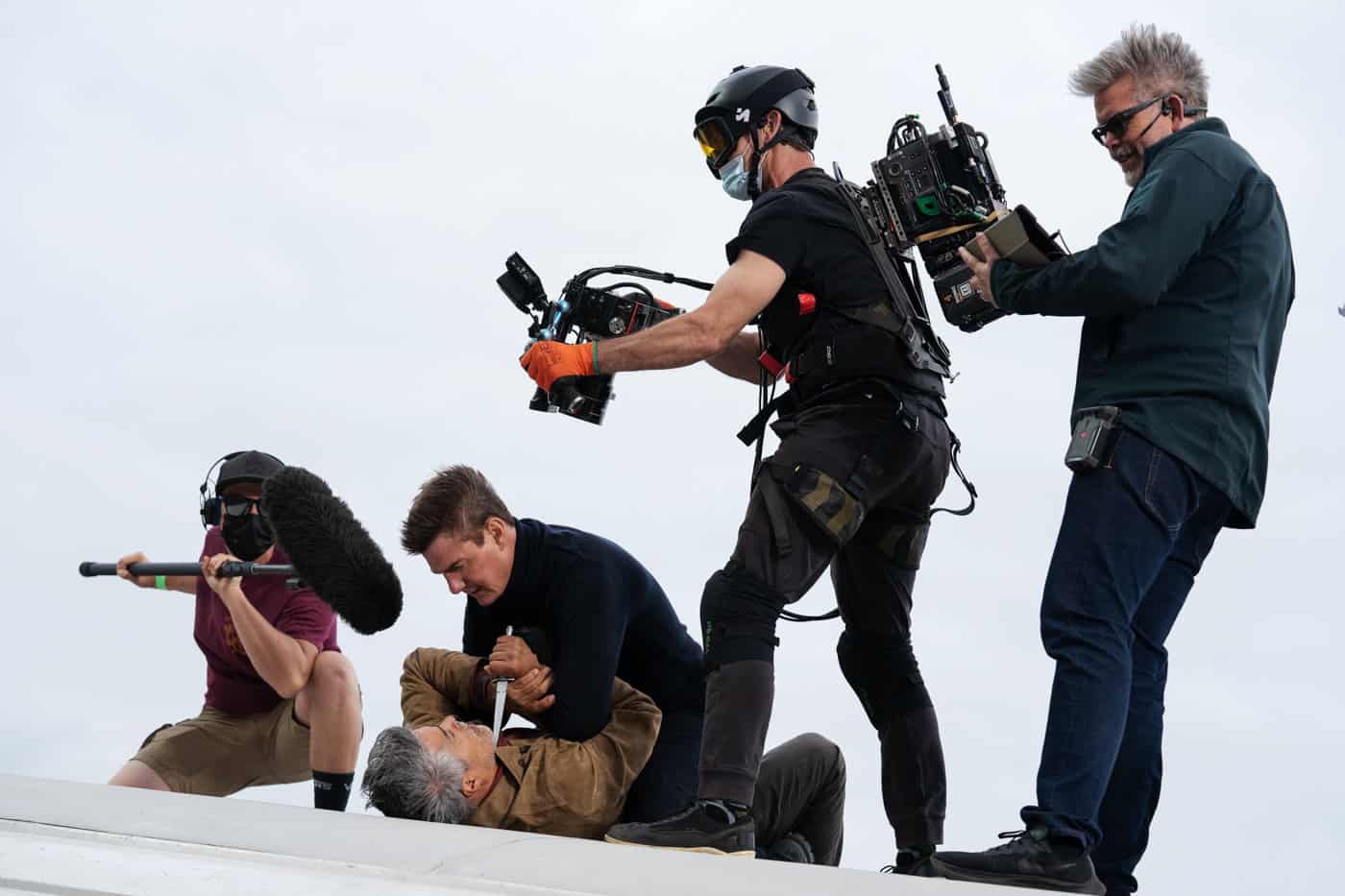
Esai Morales, Tom Cruise, A Camera Operator Chunky Richmond and Christopher McQuarrie on the set of MISSION: IMPOSSIBLE–DEAD RECKONING PART ONE
Camera Operator: To start off, I just wanted to know how you got to be involved with this project.
Chunky Richmond: Fraser Taggart, the DP, asked me to do it around June of 2019. We began shooting in Venice in February 2020, but we did a whole bunch of testing before then, and I had to get the blessing from McQ and Tom. There were reshoots on Top Gun: Maverick happening in the UK around the same, which I was part of, and I was able to get their blessing that way. I had worked with Fraser on a couple of films before, but never on his unit. I would be on second unit while he was on first or vice versa. So, for him to ask me to work with him on this, I was over the moon, to be honest with you.
CO: I imagine this was a very exciting project to get invited to be on.
Richmond: Yeah, definitely. No question about it. It’s up there with the Bond films. I’ve done a Bond, but this is something else. They’ve done most of their previous films at Leavesden Studios. I’ve been at Leavesden on other jobs, seeing their sets out on the backlot, and they’re absolutely amazing. You see that and you say to yourself, “Yeah, I’d like to do one of those.” And now I have!
CO: So, before we dive into some of the more specific stuff with the stunt sequences, I wanted to go a little bit broad. I know both Tom Cruise and Chris McQuarrie have traditionally been advocates for shooting on film. But for Dead Reckoning they made the switch to digital. On Bluesky, when he was asked about that switch, McQuarrie said that to some extent it was just a matter of what the cameras could physically survive. From a camera operator’s perspective, I’m curious if you could go a little bit more into detail on that.
Richmond: Quite frankly, after doing one of their movies, I don’t know how they ever shot it on film. Even as we were shooting digital, they were still chasing that film aesthetic, but what McQ said is 100% right. Some of this stuff you just could not do with a film camera. Just talking about the physical size of the equipment and getting yourself into positions, you’d have to use 200-foot loads, and then you’re having to stop and reload constantly which becomes a problem, particularly when you’re on top of the roof of a train. If you think the assistants are going to stand on the roof of a train that’s traveling at 50 miles an hour, checking the gate, and reloading, I just don’t know how you would do that. Nor would we have stopped the train.
CO: Beyond the train sequence, were there any other moments that come to mind where it wouldn’t have been practical or even possible to do it with a film setup?
Richmond: We were in Norway for quite a few of weeks before we did the fight scene on top of the train, and they were telling me, “Chunky, you’re going to be up on the roof shooting the fight, and it’s going to be going 50 miles an hour.” And you’re like, “Okay, right.” And it’s not until you get up there the first day that you actually realize that these people are dead serious. Suddenly you’re worried about how you’re going to get their angles. You know what a train roof is like. It is cambered, so there’s a limit to how much you can stand out on the edge. Whatever safety lines the actors are attached to, I’m attached to as well. There were steel cable lines running down either side of the train, and they were quite taut. I would have a harness on, and I would have to lean out to get around the person who has his back to me so I can see the action.
It’s like a dance, like fencing; you try to find areas where you can see the action of the story you want told. You realize that, although the two actors are acting, they’re also genuinely exhausted. It takes a lot of you to lean and push against the cable. It’s very taut, on the opposite side, and you are leaning right into it. Sometimes when it’s going around a corner, you have to fight against being pushed to the other side. It was very hard work. You’re putting your body in areas that are not normal. Leaning over the train at 50 miles per hour. There’s no question about it. One day Tom turned around and goes, “Come on, let’s do one more run.” And I just had to say, “I’m exhausted. I can’t do it.” It is unbelievably draining. We did put a crane on top of the train for a few bits, and we used helicopter work and tracking vehicles, but train tracks and roads don’t always run side by side for long periods of time, so there are only small little bits that you can film that way. Looking back on it, it’s absolutely insane. Nobody else is going to do this again like the way we’ve done it.
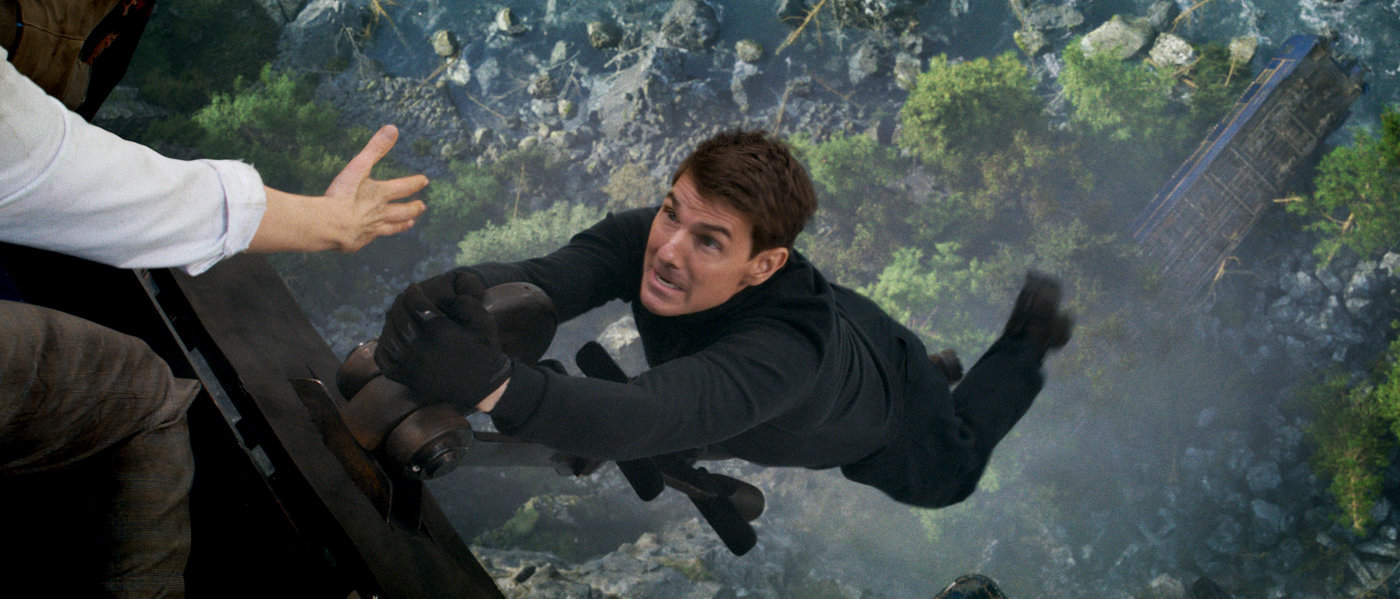
Tom Cruise in MISSION: IMPOSSIBLE–DEAD RECKONING PART ONE
CO: Yeah, it’s such a wild thing. A lot of attention with these movies is given to Tom Cruise doing the stunts, like jumping off the cliff with the motorcycle and doing the fight up on the train, but you’re also right up there with him in a lot of these situations.
Richmond: And the weird thing is, the general public probably have absolutely no idea about that. Another example is when we were inside the train as it’s going over the edge of the track, and some of the carriages are dangling straight up and down. We built this rig that can take a train carriage from level to 90 degrees. There was one shot in particular where it started off at about 45 degrees, and then it gradually moves up to the full 90 degrees. I have to lean out at that point, and although I’m in a full harness and I’ve got two safety lines on me, there is always that moment when it gets to 90 degrees and the line stretches and you don’t like it. Tom would joke around with me, “Come on, Chunky. What’s the matter? I’m doing it.” And I’d reply, “Yeah, but you’re using your hands to hold onto something. I’m holding a camera, looking down at you, and that’s the difference.”
I have to say though, Tom is extremely supportive of what the operator has to go through to achieve these shots. About 70% of the whole entire film was shot on Steadicam, even when it’s static, even when you think it’s on a head or dolly or track and it’s slowly moving, it’s all Steadicam. When the camera is running in Venice and going through these alleyways that you couldn’t fit a normal human being down, we did we used the Stabileye and an amazing operator called Ross Sheppard to hold it while I’m operating on the wheels. Ross is a young, very fit man, who did an excellent job. He was also running up and down the roof of the train, as it’s going over the edge and almost going upright as Tom and Hailey are running up. That’s how we got all those shots. So, hat’s off to him. Absolutely unbelievable. When we do those wraparound shots and everyone else is harnessed in, Ross generally isn’t. Sometime you just have to take step back and go, “This is crazy. This is my office job.”
I also want to give a massive shout out to the first AC Paul Wheeldon. Because this whole entire film was either Steadicam or Stabileye, it’s unbelievably difficult to succeed in that when your start position might have changed, it might not be exactly the same. Those small differences make such a massive difference for the focus puller, and he did an absolutely excellent job. So a big, big shout out to him.
CO: Talking about the the sequence at the end with the train cars going over the broken track. There’s a lot of impressive stunt work in this film, a lot of great set pieces, but I think more than anything else, that was the one where I just wracked my brain, trying to figure out how you would have done it.
Richmond: When we were chatting via email, you asked me did they cheat the angle, and I actually chuckled, because Tom and McQ, they don’t cheat anything. They do not cheat anything. When the train is vertical, it’s not cheated to that angle, it is actually doing that and moving and everyone inside the train has to do their job accordingly. For example, running through the kitchen car, that was very hard. It’s a kitchen, so we’ve got food and produce and whatever else all over the floor, and there’s a viscous oil coming out the chip fryer that’s pouring down the train. And although we’ve got rubber mats in there, it is very hard to walk backwards, looking forwards following them up the train. I had a pair of spikes on and at one point I still had to have a line on me and an assist because I’m using a Sony Venice in Rialto mode, so I’ve still got the gubbins of the camera and everything else on my back. When you’re on a 45-degree angle and you’re top-heavy with the camera on, pointing down, even if you’re an extremely accomplished athlete, you’re still going to struggle moving quickly backwards. So yeah, it was insane. Absolutely insane.
That’s just one small carriage. There were so many more. For example, when we’re in the last bit in the piano carriage and they’re climbing up, when he grabs the bar, you couldn’t get where the camera was by suspending a remote head and getting it close to his arm, so I’m actually harnessed in, on a line myself, so that I can go up or down, right or left, or use my feet in a certain way to angle the camera so that I can shoot all the way down his arm and get a good eye-line. So, I’m hanging upside down, blood’s rushing into my head, I probably look like a beetroot in order to get this shot. My son came down to set one day to see me work, and he was just like, my god, Dad, I had no idea this is what you do for a living.
As taxing and as stressful as this job can be—and these films are unbelievably hard to make—having Fraser as my DP makes all the difference in the world. He is such a gentleman and a very talented man, and he is a joy to work for.
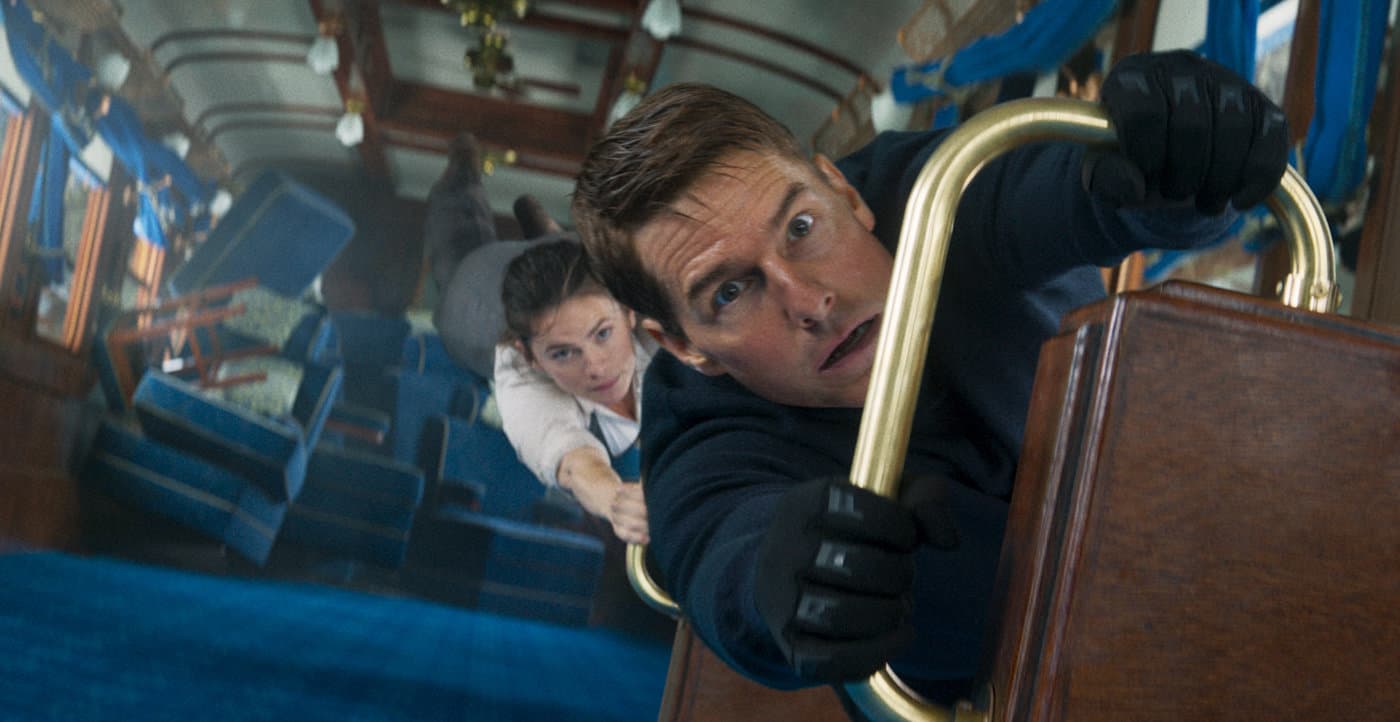
Tom Cruise and Hayley Atwell
CO: I am fascinated by how you prepare to do shots like that. There are all the regular issues of just getting the shot, making sure everything is correct and in frame, but then there’s the whole physical aspect of it as well. What is the rehearsal and prep process like? What are the steps you go through between, “Okay, here’s the shot we want to do on paper” to actually shooting the thing, hanging upside down in a train car that is tilted 90 degrees vertical?
Richmond: Well, in terms of rehearsing, that’s called take one. Sometimes Tom would walk onto the train and go, “Right, Chunky, we’re doing this in one take. I’m not doing this again.” And he doesn’t have stunt doubles, we don’t rehearse with anyone else. Sometimes I actually have no idea what he’s going to do until he’s actually done it, so I’d say, “Well, that’s two takes, Tom, because we rehearse on film, so I get one more.” So, it is difficult because in that capacity, I don’t always know what’s going on. You have a rough idea, but if you’re doing one of these shots on the Stabileye, you want to be able to rehearse a couple of times and hone it in so that you don’t cut his head off or misframe. At times, yeah, it’s unbelievably stressful, particularly when he’s pumped up and so focused and driven for these big, big stunts that are very taxing on his body.
CO: In interviews, McQuarrie has spoken about how he writes for these films, and they’re very much reverse engineered from working with Tom Cruise and saying, “Okay, here are the locations we have access to, here are the the big stunts we want to do, here are the big moments we want. How do we build the story around that?” So, even as these big stunts obviously require a lot of planning, there’s also an aspect of this that’s sort of fluid and improvisational, allowing them to hone in on the best moments while they’re shooting. Given that, I’m curious how much lead time you have on these sequences between getting script pages or being told what the plan is for the stunt and then actually being on set shooting it.
Richmond: Working on this movie, I can tell you right now that when you get script pages early on, what you’re reading is not going to be the film that ends up on screen. And the pair of them will openly admit that. It’s an evolving story, and the actors are allowed to drive the film in certain directions by finding these moments of inspiration and honing in on what works. And then they try and assemble it in such a way that it’s not five hours long, which is obviously a very hard thing to do. There’s so much good content, and sometimes the good things have to go by the wayside.
To give you an idea, our first day of filming was the big motorcycle jump. Because we were one of the first films to go back from COVID, Tom made sure that we were all safe. We were all in Norway, isolated on a cruise ship, and you turn up at this cruise ship, and you’re walking on board past 14 helicopters, just absorbing it going, “This is a bit different.” Every single person is flown in to that mountain top, and when you get there, you fly past this ramp that is built over the edge of the cliff, and you can’t help but say to yourself, “He’s off his rocker.” This ramp is about four-foot wide, they’re banging ice off of it in the mornings—it’s just nuts. And then if you want to talk about the preparation for it, back in the U.K. before we went out there, Tom was rehearsing in a quarry where we built a ramp slightly smaller, and we put boxes in a sunken area in an actual quarry. He was attached to a line and the bike was not, so he would do the jump and he would fly on a line down to safety, and the bike would go into the boxes. The motorbike didn’t have a speedometer, so has to get the right speed just by the sound of the bike. After each take he’ll look at the statistics, how fast he was going, the windspeed, how he jumped off the ramp, how he flew in the air, all of these things. He only did that for two weeks before doing the proper jump, which is amazing. But even then, he enjoyed every single test jump he did. When we did the six jumps out in Norway, we almost got it on take one, but he wanted to keep going. And you can’t blame him, really. It’s pretty amazing to say that you can do that in a day’s work.
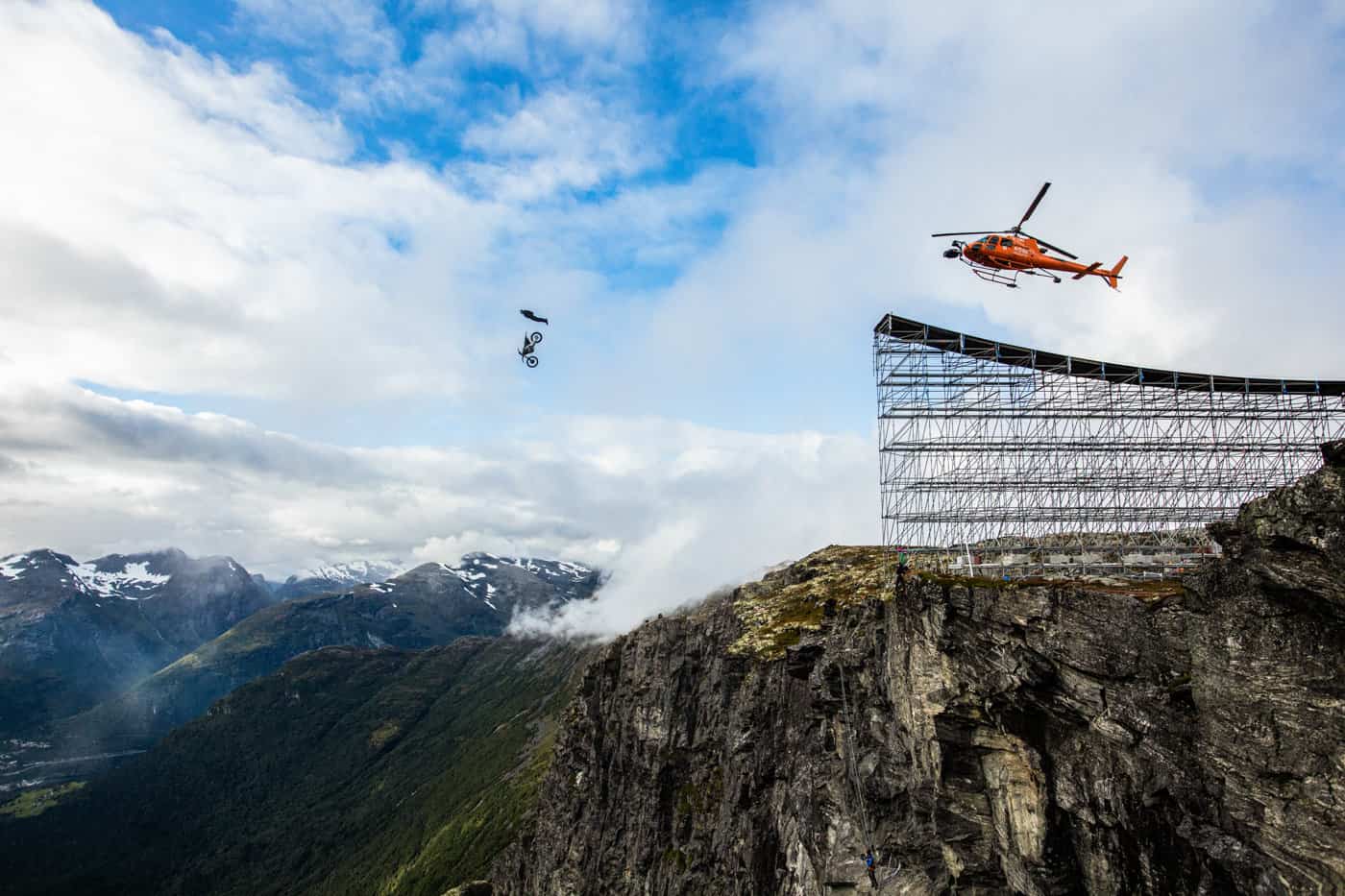
Tom Cruise performs the motorcycle jump stunt in MISSION: IMPOSSIBLE–DEAD RECKONING PART ONE
CO: Yeah, I believe it was before the IMAX version of Avatar: The Way of Water when it came out last year, that rather than a traditional trailer, they did a short behind-the-scenes preview on getting that first take of that motorcycle jump. They hadn’t done all the post production on it yet, so you could see the ramp and everything, and the reaction from people in the theater was just unreal. And you say you ultimately did six takes of that?
Richmond: I think it was six full takes, but we were also trying to figure out how to shoot it. We had drones in the air, we had helicopters in the air, we had cranes, we had people hanging off the mountain doing handheld, we even had cameras on the bike as well. We had some Z CAMs, early editions of them, and we had three of them on the front of the bike. The idea was that when he actually releases from the bike and flies through the air, we could see him traveling, they would stitch those images together. They didn’t ultimately use any of that footage, but there was a lot that went into the work of just those cameras. Basically you’re building a small array. Dani Rose from CineAero designed this, and one of the problems we had is that if you don’t turn the cameras off before the bike crashes, you’re going to corrupt the file. So Dani had figured out a way to stop the cameras running before they hit the ground. They also had little tags on them so we could have mountaineers to find these cards, but when the bike hits the dirt, it goes into 1000 pieces, and they only ever found about half of them. But the thought that goes into all this sort of stuff is unbelievable. I was on the crane hanging off the side of a mountain—not me personally, but the camera was—and that’s not in the film. Ultimately they went with the aerial shots of him going down the ramp and him going over the edge, and how can you beat that? It’s amazing. Simply amazing. After we did a take, I walked all the way up to where the grown-ups were, and had a look at the playback and went, “Oh, my God, that’s outrageous!” It’s phenomenal.
CO: Yeah, it’s a really, really impressive stunt. And that whole run we’ve been talking about, from the motorcycle jump off the mountain all the way through to the train cars going vertical over the edge of the track, it’s just a really spectacular finale for the movie. I’m curious, beyond that third-act run of set pieces, what else springs to mind as a particularly interesting story or experience?
Richmond: So, when we were in Venice, the big challenge was figuring out how to move the camera through the streets of Venice quickly. Do you get an electric bike? Do you get a scooter? Some of the alleys are so small, you can’t even fit a bike or scooter down. So, Ross Sheppard, our Stabileye operator, he’s got the camera on a pole that’s weighted in front of him with the camera hanging out the back, and I’ll operate the camera and he full on sprints down these alleyways trying to keep up with Tom, or Tom trying to keep up with him. I gotta tell you, Tom looks like he runs fast. He does. It’s unbelievable. It was always a challenge, but we got there in the end. For example, in one of the shots when he comes out of the palace, and you see all the candles on the floor, and he’s running in between the colonnades, we did that on an electric bicycle, because you can’t have other equipment to keep up with him in Venice. They don’t allow it. The permits you need to get just for shooting in Venice, it’s unbelievably difficult. The only other film in history to do night shoots like this in Venice is Don’t Look Now, for which my father was the DP. And, my dad was very curious. He goes, “What was it like?” I said, it’s impossible. You must know. Everything comes in by barge, there are no roads. It’s unbelievably difficult.
CO: Talking about those alleyways being a tight fit, the moment that springs to mind is the fight in that narrow alleyway between Tom Cruise and Pom Klementieff.
Richmond: David, that is my favorite scene of the movie. By far my favorite. I’m very, very proud of that. We shot that on stage, and as it’s being built, you’d walk past it going to other sets, and you’d always go, “Well, how the hell am I going to do that?” Again, we shot it on the Sony Venice Rialto, so I have to take all the gubbins of the camera body on my back in a rucksack, and when I walk into that alleyway, there is no turning around. I walk in and I either walk out the other way, or I back up. Because I’m shooting with a small camera in such tight space, the slightest camera moves really have a big impact. It let me really highlight the movement of the actors in the fight to make the sequence feel very visually dynamic. By far and away my favorite. I really, really enjoyed that scene.
I also wanted to discuss the opening sequence on the submarine. The control room in the submarine was shot on a gimbal rig that was 20 feet up in the air on the stage. The production team and the prop department did an absolutely unbelievable work on designing and dressing it and making it as real as possible. There have been many submarines in film, some of them are absolutely fantastic, and some of them very Hollywood. I think that ours is very, very good. The fact that the set could go 16-degrees port and starboard and tilt up and down, it was amazing. One of the things we struggled with was how the camera works in there. We only had one crane shot where we pulled out a wall and stuck the crane arm in, and that was to get over the compass so that we could have it stay level in the foreground while and everything is moving around it. There are a couple of long Stabileye shots like the opening, where the captain is stirring his tea, but we found most of the work was done Steadicam. Standing there with the Steadicam, you are balanced, but as soon as the set moves, you have to rebalance while trying to keep the camera still. It took a while to figure out what is the best way to do that. One of my favorite shots, actually, is the push in to the captain and the X.O. when they’re standing towards each other. It’s just a really fast push in that stops and locks on them. Every time I see it, I do go, “Oh yeah, that’s a good push in.” It was such fun to shoot. You really felt like you’re on board a submarine. But instead of being underwater, you’re 20 feet up in the air.
One other scene was just the most amazing event for me. It was one Saturday when we were in Abu Dhabi. We had a reduced crew, and we did the interior of the Osprey. Literally, we turn up in the morning, and we figure out the five or six shots we need to do to make this work. We start off with Shea Whigham, close up of him standing on the tailgate, then we come back for a two-shot across [Greg] Tarzan [Davis] onto him, and then we work our way slowly inside, always looking out the back to get as much of the scene, all the shots that McQ wants. We do this on the ground where we can all hear each other, because as soon as we’re up in the air you cannot hear a thing. I’m harnessed in, everyone else is strapped in, and we start flying, and as soon as I get up there, I realize I just wasn’t quite tall enough. I’m on my tip toes trying to shoot, and all of a sudden the cramps start pinging up in my body. I get it in my left calf, it starts creeping up my whole entire body. I’ve got some of the actors holding me because we’re moving around, grabbing my legs and my torso, trying to keep me in a spot, and this happens throughout the whole time we’re working our way through the shots. It was about two-and-a-half hours before we landed. I was shattered. It is grueling work doing this, but the thrill of it, oh my God, amazing. Amazing to be able to say that I shot—essentially on my day off—the scene on an Osprey flying. Those planes are fantastic and they are probably the very best on the big screen in any capacity, inside or out. They’re so majestic. It was fantastic. I feel so privileged to be able to be part of that.
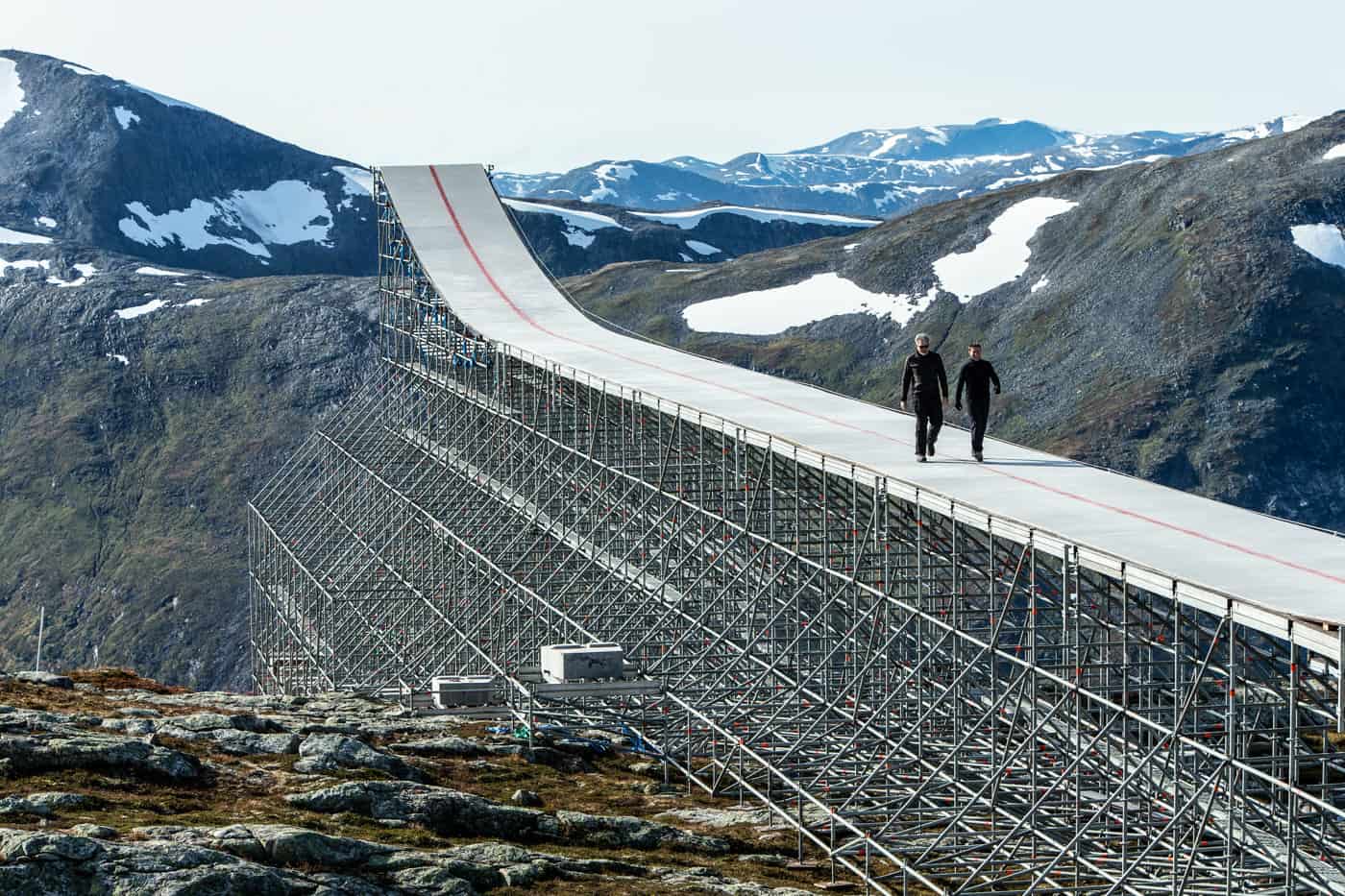
Tom Cruise and Christopher McQuarrie on set
CO: We’ve been talking a lot about specific stunts and moments in the film, I did want to pull back a little bit and talk about the style of the film. Having seen the movie a few times, there’s some really cool stuff you start to notice with the camerawork and the framing. It plays a lot with putting information in the frame that’s not necessarily the subject of the shot—it’s maybe in the background or out of focus—but you’re meant to notice it. The most obvious example would be the ramp sort of appearing in the background of the shot as Ethan is wondering how he’s going to jump from the cliff down to the train, but that sort of stuff is all over the movie. It’s funny because this movie brings back Ethan’s penchant for closeup magic from the very first Mission: Impossible, but the language of the film is doing the opposite of misdirection. It’s trusting the audience to notice things, even subconsciously, that are not necessarily the subject of the frame, but that subtly cue you for things to pay attention to. Could you talk a little bit about the thought that went into that creative choice?
Richmond: With the mountaintop in particular, there is a camera move, so you are driven to it a bit more overtly, but you’re right, there are others where it’s just there in the frame. Sometimes you wonder if the Joe Public is going to pick up on it or not, but McQ is very conscious of that all the time. He’ll be the first one to say, “Well, if it doesn’t work, it’s not gonna be in the film.”
I just have to say how unbelievably intelligent McQ is, and a great storyteller. Even these details you’re talking about are always in service of the bigger story. He would always remind me not to obsess over the small things. Keep in mind the bigger picture and not get tunnel vision. And as an operator, I do suffer from that sometimes. I get obsessed over framing or the imagery, and he was always there to remind me about the bigger picture, which is always the story. I’ve been working with him now for four years, I can’t believe it. I really enjoy working with him. I’ve never had a relationship with a director like I have with McQ. I am extremely grateful for our working relationship. I really am. It’s fantastic.
CO: I’ve not had the opportunity to meet McQuarrie, but everything I’ve seen of him in interviews and everything else, he seems so on top of it, and so in tune with the needs of the story and what the audience is going to respond to. Just the fact that he and Tom Cruise have meshed together so well over the last 10 years or so, I think it really speaks to his talent as a filmmaker.
Richmond: Particularly at the beginning of the film or when we start a new scene, when they discuss it between themselves and it is actually quite impressive. To stand there and watch them figure it out, I mean, they tear it to pieces, and then build it back up. I’ve never really seen that happen before. Normally that’s a process that is not done in front of people on a set. This is something they do so they completely understand in which direction they’re going. It’s a real joy to watch actually. I can’t express to you how different these films are to anything else I’ve ever done. For the last four years that I’ve been involved in this, when I have my kids over the weekend, what is it you think they want to watch? They want to watch a Tom Cruise film. Mission: Impossible II, 5, 6, you know, I’ve seen them all, and every weekend it’s what they want to watch. My boys, they absolutely love it. We could sit here all day and say, “What about this? What about that?” and I’d have an amazing story for each one, because the whole film is like that. I saw it four times in a month before it was released, and I’m actually really looking forward to when it’s going to be released on home video. I’m gonna sit and enjoy it, and really soak it in.
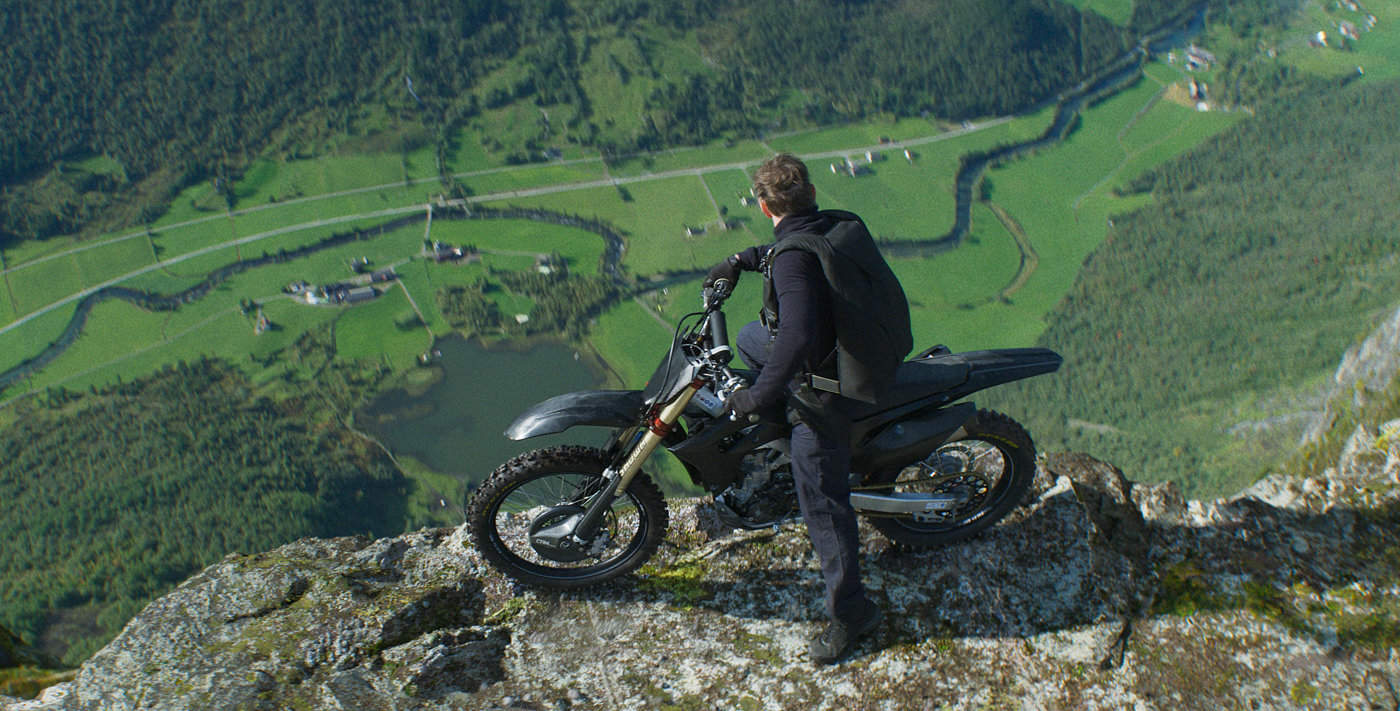
Tom Cruise in MISSION: IMPOSSIBLE–DEAD RECKONING PART ONE
Camera Operator Fall 2023
Above Photo: Esai Morales and Tom Cruise during the fight scene atop the moving train. Photo by Christian Black
Photos courtesy of Paramount Pictures & Skydance
TECH ON SET
Sony VENICE in Rialto Mode
ARRI ALEXA Mini LF
Z CAMs
Technocrane
GF-8 Crane
Libra Remote Head
Steadicam
Stabileye
Panavision C Series Anamorphic Lenses, 40mm & 60mm
BEHIND THE SCENES
Select Photo for Slideshow
Chunky Richmond
During a career in film and television that has spanned 30 years, Chunky Richmond has moved through the ranks of the camera department, starting off as a camera loader on The Sandlot, moving on to be a first AC on films like Quantum of Solace, Children of Men, and Clash of the Titans. For the last decade, Chunky has worked as a camera operator with credits including F9, The Kid Who Would Be King, Beauty and the Beast (2017), and Kingsman: The Secret Service.
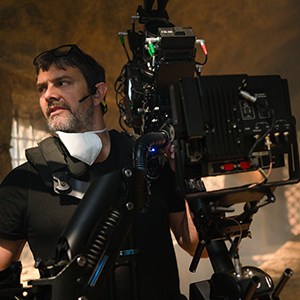
David Daut
A writer and critic for more than a decade, David Daut specializes in analysis of genre cinema and immersive media. In addition to his work for Camera Operator and other publications, David is also the co-creator of Hollow Medium, a “recovered audio” ghost story podcast. David studied at the USC School of Cinematic Arts and works as a freelance writer based out of Long Beach, California.
